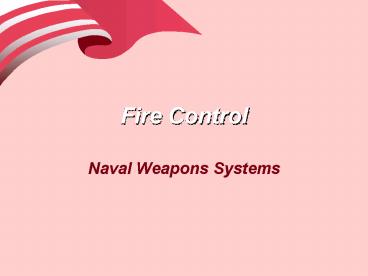Fire Control PowerPoint PPT Presentation
1 / 22
Title: Fire Control
1
Fire Control
- Naval Weapons Systems
2
We Know
How the target is detected, How the target
is tracked, How the weapon is
launched, How the weapon is
propelled, How the weapon finds the
target, How the weapon knows when to
detonate, How the weapon detonates.
What is missing?????
3
The Fire Control Problem
Factors affecting the problem - Effects of
relative motion during flight - Effects of
physical phenomena (exterior
ballistics)
4
Relative Motion
- Present target position
- Relative velocity
- Own ship motion NOT WEAPONs
- Target motion
- Bearing rate
- Speed across line-of-sight
- Future target position
5
Relative Motion
The apparent motion of an object when viewed from
a point.
C
20 mph
10 mph
B
10 mph
A
- Relative Velocity
6
Affects of Target Relative Motion on
Range and Bearing
Future Position
Present Position
Bearing Change
Ships Heading
Present Range
Range Change
Future Range
Present Bearing
- Bearing Rate / Xdmho
- Future Position
7
TMA Solving the Relative Motion Problem
8
Ballistics Problem Getting the Weapon to the
Target
- Target Data
- Position from sensors
- Motion from TMA
- Own ship data
- Weapon exterior ballistics
9
Exterior Ballistics
- Gravity
- Drag
- Wind
- Drift
- Coriolis force
10
Effects of Gravity
Line of Fire
Line of Sight
Gravity tends to accelerate objects downward.
(The longer the flight time the more the curve)
11
Effects of Drag
Drag is loss of energy of a projectile during
flight.
Energy is lost through a. Creation of air
waves (function of projectile shape) b.
Creation of suction and eddy currents (shape)
c. Formation of heat (friction)
Drag will change the aim point by changing the
speed of the projectile, increasing flight time,
increasing curve caused by gravity.
12
Effects of Drift
Drift is caused by the rotation of a projectile
(rifling). Drift results in a lateral
displacement in flight path.
Vertical Plane
Drift
Line of Fire
Horizontal Plane
Spinning top phenomenon
13
Effects of Wind
Line of Fire
Line of Fire
Horizontal Effects
Vertical Effects
14
Coriolis Effect
Caused by the earths rotation. Results in
apparent a right curve in the northern
hemisphere, left in southern.
10 mph
20 mph
15
Fire Control Problem
- Input
- Target data
- Own ship data
- Computations
- Relative motion procedure
- Exterior ballistics procedure
16
Fire Control Problem Cont.
- Solutions
- Weapons time of flight
- Bearing rate
- Line of Sight(LOS) The course the weapon must
follow to intercept the target - Speed across LOS
- Future target position
- Launch angles
- Launch azimuth
- Launch elevation
- Weapon positioning orders
- Block diagram of fire control problem
17
Solving the Fire Control Problem
Continuously Measure Present Target Position
Compute Relative Target Velocity
Stabilize Measured Quantities
Environmental Inputs
Weapons Positioning orders
Ballistic Calculations
Unstabalized Launch Angles
Future Target Position
Time of Flight
Launch Angles (Stabilized)
Relative Motion Calculations
Prediction Procedure
18
The Iterative Process to the Fire Control
Solution
Step 1
Step 2
Step 3
Last Step
19
A 3-Dimensional Problem
Line of Sight
Present Range
Target Elevation
Gun Elevation
Horizontal Reference Plane
20
What You See
21
What You See 2
CIC of an Arleigh Burke
CDC of Stennis
22
HOMEWORK 14
- Workbook Ch. 19 1,2,4

